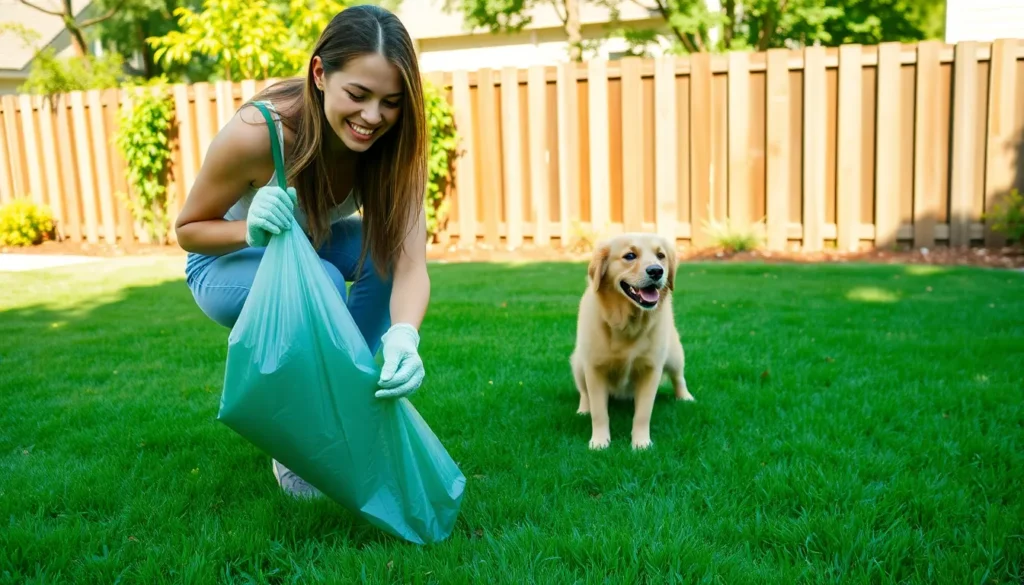Choosing the right pet for a child can feel like navigating a jungle of fur, feathers, and scales. Parents often wonder which furry friend will bring joy without turning their home into a chaotic zoo. After all, kids have enough energy to power a small city—who wants to add a high-maintenance pet into the mix?
Table of Contents
ToggleUnderstanding Children’s Responsibilities with Pets
Children often benefit from the experience of caring for a pet. Caring for pets fosters responsibility and teaches empathy, skills crucial for personal development. Involving kids in pet care ensures they learn how to manage time and commitments effectively.
Feeding pets provides an excellent opportunity for children to gain a sense of duty. Dogs, for example, typically require daily feeding and fresh water, offering a routine for kids to follow. Cleaning up after pets teaches lessons about hygiene and the importance of maintaining a clean environment.
Taking dogs for walks presents an excellent physical activity for children, enhancing their understanding of exercise and its benefits. Basic grooming, such as brushing a cat, introduces children to pet health care, developing a connection between care and well-being.
Understanding pet behavior also encourages children to observe and respond to needs. Recognizing when a pet wants to play or needs space enhances a child’s critical thinking skills.
Weekly responsibilities can include taking the pet to the vet for check-ups or vaccinations. This heightens awareness of the pet’s health needs and the importance of preventative care. Children learn budgeting skills when discussing pet expenses, such as food and supplies.
Choosing a low-maintenance pet often aligns with children’s abilities. Fish, for instance, require less interaction while still allowing children to develop care routines. Small animals like hamsters or guinea pigs also offer manageable responsibilities, serving as stepping stones for more involved pet ownership in the future.
Monitoring children’s engagement with pets ensures they maintain interest and care levels without feeling overwhelmed. Planning rewards for completing tasks can further encourage commitment, making pet care a rewarding experience for both children and pets.
Popular Pets for Kids

Selecting a suitable pet for children can lead to joyful experiences without significant stress. Low-maintenance options often provide great companionship and teach kids valuable lessons.
Fish
Fish serve as beautiful additions to a child’s life. They require minimal care, making them perfect for young kids. Regular feeding and water changes keep the environment healthy. An aquarium can foster interest in aquatic life, enhancing educational opportunities. Various species offer visual appeal and act as a calming presence.
Hamsters
Hamsters are small, playful, and easy to manage. These pets typically live 2 to 3 years, which allows kids to learn about responsibilities in a shorter timeframe. They love to explore, running on wheels and engaging with various toys. Cleaning their cage promotes hygiene awareness while kids enjoy the fun of watching their behaviors. Storing food in their cheeks showcases their cute antics.
Guinea Pigs
Guinea pigs are friendly and social creatures that thrive on interaction. They can live up to 6 years, providing a longer-term commitment compared to other small pets. Caring for guinea pigs involves simple tasks like feeding and grooming. Their docile nature makes them great companions for kids, promoting empathy and nurturing attitudes. These pets also communicate through sounds, creating a lively experience for families.
Cats
Cats represent independent yet affectionate companions. They require less direct care than dogs, making them relatively easy for kids to manage. Basic needs include regular feeding and litter box maintenance. Kids experience responsibility as they learn to respect a cat’s space. Their playful nature often brings entertainment, as they engage in fascinating antics, enriching family life.
Dogs
Dogs, while requiring more attention, provide unmatched loyalty and companionship. Various breeds present different energy levels, suiting diverse family lifestyles. Daily walks give kids physical activity and teach routines. Training sessions enhance bonding while instilling discipline and responsibility. Engaging with dogs promotes social skills, as they often interact with other pets and people in the neighborhood.
Factors to Consider When Choosing a Pet
Several factors influence the decision when selecting a pet for children. Parents should evaluate each aspect carefully to ensure a suitable match.
Space Requirements
Space significantly impacts pet choice. Larger animals like dogs often require ample room to roam and play. In contrast, hamsters and fish require little space, making them ideal for apartments or smaller homes. Assessing available areas in the home helps determine whether a pet can thrive in that environment. Outdoor spaces also play a role; a backyard may facilitate outdoor pet activities, enhancing the pet’s quality of life.
Care and Maintenance
Care and maintenance levels vary among pets. Simple pets like fish require basic feeding and tank cleaning, making them low-maintenance. Small mammals like guinea pigs need regular cage cleaning but typically ask for less than dogs or cats. These animals may require frequent grooming, exercise, and social interaction. Consider the daily time commitment needed to ensure a healthy, happy pet, as this impacts children’s ability to care for them effectively.
Allergies and Sensitivities
Allergies and sensitivities pose crucial considerations. Some children may experience allergies to fur or dander from cats and dogs. Fish and reptiles generally lead to fewer allergy concerns. Determining any allergies within the household helps narrow down suitable pet options. Consulting with an allergist may provide helpful insights and lead to making informed decisions to avoid health issues.
Benefits of Having a Pet for Kids
Having a pet offers several advantages for children. Pets can teach kids responsibility through daily care tasks. Engaging in feeding routines allows children to understand the importance of commitment. Kids develop empathy as they learn to recognize and respond to a pet’s needs.
Social skills improve when children interact with pets. Playing with pets promotes cooperation and communication. Kids often share their experiences with friends, fostering a sense of community. These interactions provide opportunities for children to express their feelings and build friendships.
Health benefits also arise from pet ownership. Studies show that children with pets tend to have lower stress levels. Having a pet encourages physical activity, whether through playtime or regular walks. Increased outdoor activities contribute to overall fitness and well-being.
Learning opportunities abound with pets. Kids gain insights into animal behavior, biology, and care. Pets can spark curiosity about nature, encouraging exploration and discovery. This educational aspect enables children to appreciate the natural world.
Developing routines around pet care instills discipline and time management skills. Children learn to schedule pet activities alongside their responsibilities, enhancing organization. Consistency in routines builds a sense of security, benefiting their emotional development.
These benefits create a strong foundation for personal growth. Children who care for pets often show increased confidence and self-esteem. Ownership fosters a sense of accomplishment, guiding kids as they navigate various life challenges. Overall, having a pet proves to be a valuable part of childhood development.
Choosing the right pet for a child can be a rewarding journey that enhances family life. By selecting a low-maintenance option like fish or small mammals, families can enjoy the benefits of pet ownership without overwhelming responsibilities. These pets not only provide companionship but also teach valuable life skills such as responsibility and empathy.
As children engage in pet care, they develop routines that foster discipline and time management. Ultimately, the right pet can contribute to a child’s emotional and social growth while bringing joy to the entire household. With thoughtful consideration, parents can ensure a harmonious relationship between their children and their new furry or finned friends.








